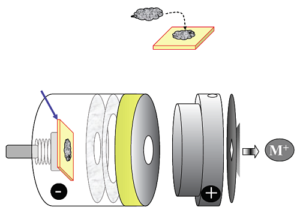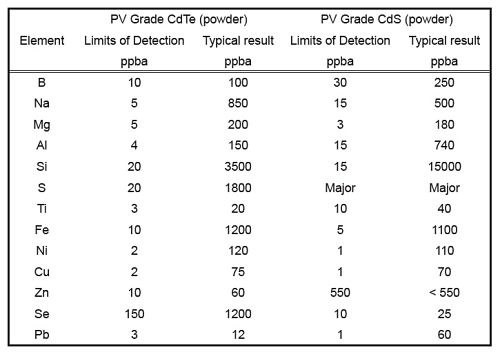Element Determinations in Photovoltaic (PV) Grade CdTe/CdS Powders
Home » Element Determinations in Photovoltaic (PV) Grade CdTe/CdS Powders
Cadmium telluride (CdTe) has been shown to be one of the most promising polycrystalline materials for producing thin film PV solar
cells (CdTe/CdS) because of its high absorption coefficient (α > 104 cm-1) and a band-gap of 1.5 eV, which is well matched to the solar spectrum. In addition, of the various commercial or near commercial thin film technologies, PV grade CdTe has a very favorable combination of performance, manufacturability, cost, and upside performance potential. Several elements, even in trace levels, are shown to have a major impact on the performance of the final devices. Historically, it has been seen that raw material batches from the same purity grade show differences in impurity level of critical elements. It is believed that these fluctuations in purity level are linked to observed differences in final device efficiencies and long-term performance.
DISCUSSION
A number of analytical techniques can be used for trace element monitoring of PV grade CdTe/CdS materials. These include both wet chemical and direct solid sample introduction methods.

However, accurate wet chemical analyses tend to require complex dissolution procedures that normally involve the use of combinations of concentrated acids prior to analysis, for instance by Inductively Coupled Plasma Optical Emission or Mass Spectrometry techniques (ICP-OES/MS).
Wet chemical methods can be complicated, they also dilute the sample by several fold, and may result in the loss of some of the volatile analytes during the dissolution process.
High Resolution Glow-Discharge Mass Spectrometry (GDMS) based on reduced pressure GD ion source operating with flat-cell geometry is an ideally suited analytical technique for complete, precise and accurate element characterizations of powdered/particulate materials. Figure 1 shows VG9000 – Mega Flat Cell Assembly for CdTe Powder Analysis.

The growing attention to GDMS for trace element characterizations of PV grade CdTe/CdS powders is mainly due to its ability to quantify almost all elements in solid samples with sensitivity down to the ultra-trace range (Table 1). Due to the technique’s excellent reproducibility the quality of the raw materials can be easily monitored. Besides bulk element analyses, glow discharge is also an excellent method for depth profile measurements on the final deposited films.
Would you like to learn more about Element Determinations in Photovoltaics?
Contact us today for your element determinations in photovoltaic needs. Please complete the form below to have an EAG expert contact you.